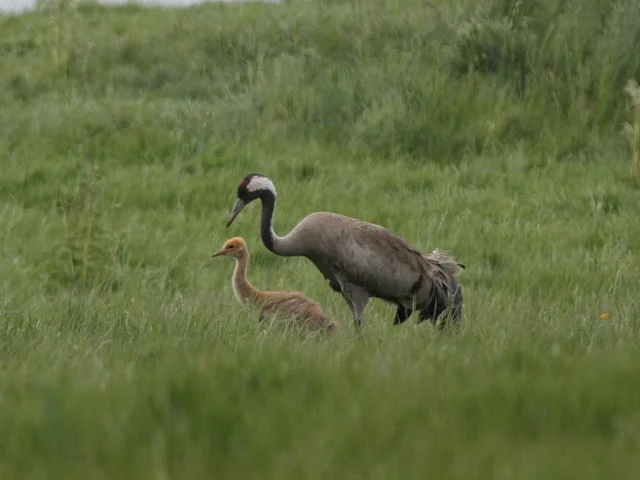Cranes breed in Scotland
2705c1e2-124f-485e-9b11-22ca9fd58766

For first time since Middle Ages, Common Cranes have raised young in Scotland, on a farm whose precise location has been withheld.
The striking wading birds have successfully raised two chicks within the last two years in North-East Scotland, said the RSPB, indicating conditions could be right for the species to recolonise Scotland.
Small but increasing numbers of the migratory birds, which spend summer in northern Europe and winter in southern France and Spain, have passed through Britain in recent years and a small breeding population became established in Norfolk in 1979, with further breeding in Suffolk. However, these are the first confirmed successful nests north of the border for hundreds of years.
Common Crane once bred regularly in Scotland but died out about 400 years ago, primarily due to being hunted for mediaeval tables. Habitat loss and a slow reproductive cycle may have also contributed to the species' disappearance.
The species, which favours large wetland areas such as lowland peat bogs with an abundance of pools, appears to be benefitting from farming methods in the area which provide plentiful invertebrates, grain and other foods, as well as the right conditions to breed and successfully raise chicks.
Stuart Housden, Director of RSPB Scotland said: “We are stunned and delighted to see that Common Cranes have bred successfully in Scotland. These charming, elegant birds have a strong place in our myths and history and are a delight to see, particularly during the breeding season with their 'dancing' displays. They undertake regular migrations and small numbers have turned up on the east coast of Scotland in recent years, raising hopes of a recolonisation. Last year a pair reared one chick, followed by a second chick in 2013.
“Thanks to the co-operation of farmers in the area, the conditions appear to be right for cranes to take up residence and it is possible that more will choose to re-establish themselves in the country in future.
“We have been working with local farmers, landowners and the community to monitor these fantastic birds. Despite their size and flamboyant breeding displays, cranes are secretive birds and are very sensitive to disturbance and we ask that they be given space and peace so they may establish a breeding population in Scotland.”
To minimise risk of disturbance, the exact location of the nest site has not be revealed. The British breeding population stood at 17 pairs in 2011. In addition to natural re-colonisation, a re-introduction project began in 2010 on the Somerset Levels, the result of a partnership between RSPB, WWT, Pensthorpe Conservation Trust and Viridor Credits.
RSPB’s Loch of Strathbeg nature reserve, a major coastal wetland near Fraserburgh, is visited by cranes on spring migration and offers the best opportunity to see them doing their ‘dancing’ displays.
The striking wading birds have successfully raised two chicks within the last two years in North-East Scotland, said the RSPB, indicating conditions could be right for the species to recolonise Scotland.
Small but increasing numbers of the migratory birds, which spend summer in northern Europe and winter in southern France and Spain, have passed through Britain in recent years and a small breeding population became established in Norfolk in 1979, with further breeding in Suffolk. However, these are the first confirmed successful nests north of the border for hundreds of years.
Common Crane once bred regularly in Scotland but died out about 400 years ago, primarily due to being hunted for mediaeval tables. Habitat loss and a slow reproductive cycle may have also contributed to the species' disappearance.
The species, which favours large wetland areas such as lowland peat bogs with an abundance of pools, appears to be benefitting from farming methods in the area which provide plentiful invertebrates, grain and other foods, as well as the right conditions to breed and successfully raise chicks.
Stuart Housden, Director of RSPB Scotland said: “We are stunned and delighted to see that Common Cranes have bred successfully in Scotland. These charming, elegant birds have a strong place in our myths and history and are a delight to see, particularly during the breeding season with their 'dancing' displays. They undertake regular migrations and small numbers have turned up on the east coast of Scotland in recent years, raising hopes of a recolonisation. Last year a pair reared one chick, followed by a second chick in 2013.
“Thanks to the co-operation of farmers in the area, the conditions appear to be right for cranes to take up residence and it is possible that more will choose to re-establish themselves in the country in future.
“We have been working with local farmers, landowners and the community to monitor these fantastic birds. Despite their size and flamboyant breeding displays, cranes are secretive birds and are very sensitive to disturbance and we ask that they be given space and peace so they may establish a breeding population in Scotland.”
To minimise risk of disturbance, the exact location of the nest site has not be revealed. The British breeding population stood at 17 pairs in 2011. In addition to natural re-colonisation, a re-introduction project began in 2010 on the Somerset Levels, the result of a partnership between RSPB, WWT, Pensthorpe Conservation Trust and Viridor Credits.
RSPB’s Loch of Strathbeg nature reserve, a major coastal wetland near Fraserburgh, is visited by cranes on spring migration and offers the best opportunity to see them doing their ‘dancing’ displays.

